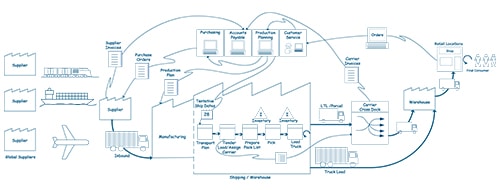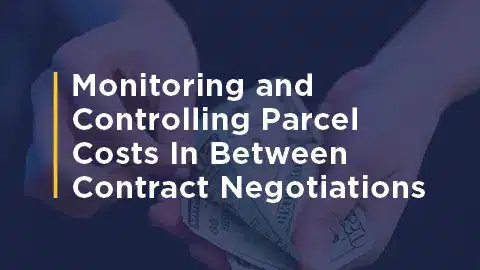
However, in the wake of a global pandemic where both short- and long-term effects are still emerging across shipping networks, there’s limited value in a rear-view look. This is especially true as North America continues to emerge from a stay-at-home state.
Organizations need a rear-view look, as well as in-depth awareness of current activity and the financial implications. Add contingency scenarios to requirements for companies pursuing supply chain optimization to support the “whack-a-mole” recovery where product demand and service requirements vary widely for customers across different geographies.
In the wake of pandemic, transportation managers determining how to optimize supply chain processes benefit significantly from end-to-end supply chain visibility. Solutions for achieving that visibility are widely available, but not all shipping network optimization solutions are equal. And not all visibility is the same. Your business objectives determine the level of visibility you need to make the best decisions.
What is Supply Chain Visibility?
Supply chain visibility means different things to different people. It covers everything from the physical “Where is my shipment?” to the virtual, like “Which customer/SKU combinations are profitable?” Depending on your role in an organization, you may be more concerned with the operational aspects of visibility or the more strategic. Either way, you need the information you need when you need it.
Beyond physical and virtual visibility separation, there’s the difference between real-time data and real-time access to data. When it comes to data, there is a lot of it, and it is coming from a growing diversity of sources – often separated within your organization by operational and functional silos.
An expanding list of technology-driven solutions offer varying degrees of visibility, and you can gain improved supply chain clarity through internal efforts and external partners. In weighing these options, it is important to consider:
- Which solution is best for your business objectives?
- How do you leverage information in business decisions?
- What investments provides the greatest return?
Supply chain visibility can be complicated. It doesn’t have to be.
Peeling back layers of supply chain visibility, you gain an understanding of the information you need to plan and execute your day-to-day activities as well as adjust your strategy; react to changes that impact performance; and enhance your service to partners and customers.
Visibility and Supply Chain Optimization with Disruption Planning
The U.S. Armed Forces are a role model for logistics and supply chain optimization during crisis. Planning is critical to the military’s risk management focus. To quote General Dwight Eisenhower “Plans are useless, but planning is indispensable.” Companies have to be in a continuous planning mode, as we move through the recovery to account for these shifts in demand.
Effective supply chain planning, like military leadership during crisis, relies on visibility to a single source of information. When you have to go to multiple places to piece a story together, it takes time, and time can be costly.
Organizations that map their end-to-end supply chain create one foundational information source that can support business operations through disruption. As noted by Dr. Yossi Sheffi, director Massachusetts Institute of Technology Center for Transportation and Logistics, this requires supply chain mapping that goes beyond identifying company suppliers. It requires physical locations of supplier plants and warehouses.

Supply Chain Value Stream Map
“For large and complex enterprise with thousands of suppliers around the globe, mapping is a massive exercise that cannot be done on the fly,” Sheffi says.
Likewise, mapping cannot be accomplished without awareness to all activities across your supply chain. Your supply chain network and design optimization depends on your ability gain the visibility required to answer seven important transportation management questions.
Supply Chain Optimization: 7 Questions of Visibility
Peeling into the supply chain visibility layers – the physical (where is my shipment?) and virtual (which customer/SKU combinations are profitable?) – business leaders can uncover data evidence to drive decision-making around optimal supply chain network design.
Where and when?
At its most basic, supply chain visibility gives you physical location of a product in the supply chain. This can include where an inbound shipment is, where you have inventory, or when a shipment will arrive at a customer. When you have this type of visibility, you can make decisions around production scheduling, facility/customer alignment and proactive communication to customers for delivery expectations. Visibility allows the awareness needed to provide the highest level of customer service while maintaining cost control.
Where are the suppliers?
Understanding your suppliers’ geographic location is critical not only to executing a robust network design but also in mitigating risk. Understanding the production and shipping locations of your suppliers during a period of disruption allows you to execute contingency plans developed during modeling exercises.
For instance, when an overseas disruption affects a foreign supplier, maintaining a geographical awareness of primary supply chain partners is vital. Combine location information with advanced understanding of alternative sources and you can facilitate a rapid crisis response that protects customer experience and prevents other breaks in the supply chain.
Where are the customers?
Your customers and their demand drives everything about your supply chain. From the locations of your distribution centers to the shipping options available to meet customer service requirements, having a detailed understanding of the concentration of demand means you can work backwards to develop efficient and reliable options to keep them happy.
Take for example an emerging market in a different region of the country. Customer expectations for delivery are very high. Not providing a high level of service is not an option. Options exist to leverage expedited freight but may make the price point too high or erode the margin on the product. A partner warehouse may be a good option to position inventory to meet service levels without investing in owned brick and mortar.
Where is the inventory?
Your physical assets connect the vendor and customer locations. These assets allow you to position inventory to mitigate risk while providing the service customers expect. Having complete visibility to where and how much inventory you have is critical to making smart sourcing decisions:
- From which location can I fulfill the order?
- Is it cheaper to consolidate or split the order?
- Can I drop ship?
Understanding all of the inventory options available enables you to leverage your vast web of connections throughout your supply and customer base to delight your customers.
Can I access all my data?
Your supply chain generates a tremendous amount of data. Accessing all of it is not easy, especially when you are working across multiple vendors, customer segments, product categories or transportation modes. Consolidating your information across disparate systems and sources is the first step toward gleaning actionable improvement opportunities from your supply chain data. The more access to information you have, the more it can impact your ability to achieve supply chain optimization – and affect your bottom line.
An expert partner with significant technology capabilities can compile disparate data in an accessible repository and provide it in personalized dashboards, as well as apply experience-inspired analysis. Accessing that analysis in the same platform as operational data and tactical execution activities is critical to supporting quick, evidence-based decision-making.
What is Cost to Serve?
For each product and customer, executive leadership needs to understand cost to serve, which reflects all the activities and costs incurred as movement and conversation occurs from vendors through your network out to the customer. Cost to serve metrics provide actionable information by enabling visibility into the profitability of individual customers and products, and finding a fulfillment configuration that balances service and margin.
By utilizing actionable data derived from historical shipment information and running what-if scenarios with regional data and characteristics, you can develop the most responsive and efficient supply chain that meets customer demand for the best cost.
Why is my cost going up/down?
Leveraging robust score cards can provide insight into the factors that are driving your financial performance. Not all drivers are completely controllable. You cannot make your customer order from a different location or change what they want to buy. There is an old adage “you cannot change how other people act, only how you react to them.” The same holds true for the supply chain. Develop plans to react to supplier performance and customer behavior to set up your company for success.
It is absolutely critical to have an unbiased party developing and interpreting the scorecards and information produced. You want objective viewpoints that highlight all options available to contend with dynamics in the marketplace. Not only do you want a view into your data but also what is going on within the market. In the modern environment, it is more critical than ever to leverage every bit of available information across the marketplace.
Combine Layers for Supply Chain Optimization
Physical visibility to shipment, service and costs can be accessed through very basic solutions that exist in the marketplace, some at low or no initial cost. Customization often requires additional investment, and visibility is black and white based on data made available by vendors, clients or carriers. A basic Transportation Management System provides tactical visibility to all of the connections in the supply chain, and it can enable cost savings.
Virtual visibility to all the activities that drive cost, service and reliability allows you to delve into the “what” and “why” around supply chain performance systematically and regularly. This requires investment in people, process and technology. The return on that investment: an enhanced ability to react to supply chain changes that impact performance. You also improve service to partners and customers.
Visibility does not just happen, and it is not free. Corporate alignment from the top down is required to achieve a complete solution. You want knowledgeable resources with broad experience to help guide you.
Open Mastering Your Supply Chain: Layers of Visibility to gain the end-to-end network clarity you need to optimize your supply chain. Read it today and uncover information you need to drive competitive advantage.








